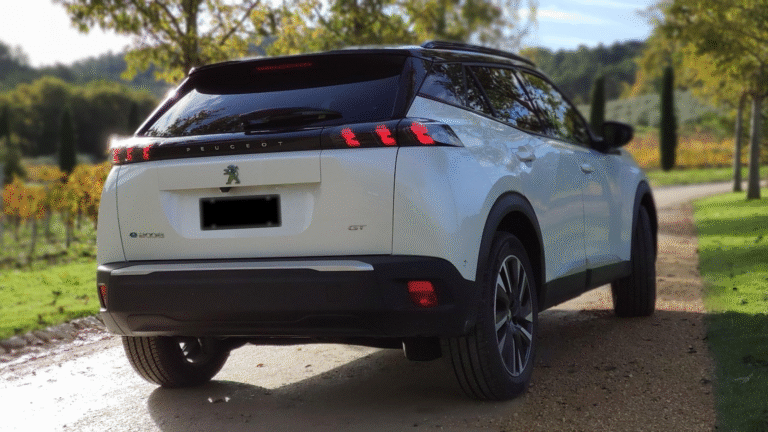The electric compact SUV space is getting crowded, but Peugeot brings a uniquely European flair to the segment with the e-2008. As more Australians consider EVs that balance style, urban practicality, and solid driving dynamics, the e-2008 steps in as an under-the-radar contender.
We took it for a spin across city streets, suburban roads, and a few open highways to see how it stacks up in real-world Aussie conditions.
Table of Contents
- Overview: The French Contender Enters the EV Market
- Exterior Style: Peugeot’s Signature Design Language
- Inside the e-2008: Comfort, Tech and Space
- Driving Dynamics: Quiet Confidence on the Road
- Range, Charging and Efficiency
- Is It Practical for Australian Drivers?
- Where It Stands Among EV Rivals
- Conclusion
1. Overview: The French Contender Enters the EV Market
The Peugeot e-2008 is a fully electric version of the brand’s popular compact SUV. With a 50 kWh battery, a front-mounted 100 kW motor, and a WLTP range of 328 km, it’s designed more for urban and suburban use than long-haul road trips. Still, with Peugeot’s signature handling and style, it offers something a bit different in the EV field.
While Peugeot isn’t the first name that comes to mind when thinking EV, the e-2008 offers a fresh alternative to the usual suspects like the MG ZS EV, Hyundai Kona Electric, and BYD Atto 3.
2. Exterior Style: Peugeot’s Signature Design Language
One thing Peugeot has nailed is style. The e-2008 is a sharp-looking SUV, with:
- Claw-like LED daytime running lights
- Strong front grille design (in body colour)
- Sculpted lines and chrome touches
- Unique alloy wheel designs for the EV variant
It’s compact but doesn’t look small. The ride height is spot on for suburban curb-hopping, while the styling turns more heads than you’d expect for a compact electric SUV.
3. Inside the e-2008: Comfort, Tech and Space
Peugeot’s i-Cockpit layout remains divisive, but it’s undeniably premium for this price point.
Interior highlights include:
- 3D digital driver display
- 10” touchscreen infotainment with Apple CarPlay and Android Auto
- Ambient lighting
- Mixed fabric and leatherette seats with contrast stitching
The seating position is slightly different due to the small steering wheel and raised instrument cluster, but it quickly becomes second nature. The cabin materials feel more upmarket than many rivals in this segment, especially at touchpoints.
4. Driving Dynamics: Quiet Confidence on the Road
On Australian roads, the e-2008 feels composed and agile. While it doesn’t boast blistering acceleration (0–100 km/h in around 9 seconds), it’s got enough zip for city merges and suburban hills.
Ride and handling impressions:
- Quiet cabin with excellent road noise insulation
- Light steering, great for tight city corners and parking
- Firm but comfortable suspension—good balance for Aussie road surfaces
- Regenerative braking is subtle but helpful
It’s not sporty, but it is refined. The suspension setup smooths out rough patches without wallowing, and it handles twisty roads with European composure.
5. Range, Charging and Efficiency
The e-2008 is built for everyday practicality, not long-distance travel.
Battery and charging specs:
- 50 kWh battery (46.3 kWh usable)
- 100 kW DC fast charging (10–80% in ~30 minutes)
- Type 2 and CCS2 compatible
- Up to 328 km WLTP range (closer to 260–280 km in mixed Aussie driving)
It’s ideal for commuters and city-based drivers who can charge at home or use fast-chargers occasionally.
6. Is It Practical for Australian Drivers?
The Peugeot e-2008 might be compact, but it’s surprisingly versatile.
Practicality features:
- 434L boot with flat floor and low load lip
- Split-folding rear seats for added cargo space
- Decent rear legroom for a car this size
- Roof rails for added flexibility
It fits into tight inner-city spots easily while still offering the boot and cabin space to handle shopping trips, a dog, or a weekend getaway for two.
7. Where It Stands Among EV Rivals
Compared to similarly sized EVs in Australia:
- It’s more stylish than the MG ZS EV, with a more premium interior
- Not quite as quick as the BYD Atto 3 or Kona Electric
- Feels more refined and quieter than most in this class
- Slightly less range than some newer Chinese rivals, but enough for daily needs
What sets it apart is character—it doesn’t feel mass-produced or utilitarian. It’s a small EV with soul.
8. Conclusion
The Peugeot e-2008 isn’t the most powerful, the most spacious, or the cheapest compact EV in Australia—but it might be the most charming. It brings European finesse, distinctive styling, and a level of comfort and quietness that punches above its segment. For urban Australians who want something different in their EV journey, the e-2008 is worth a serious look.
We test drive the Peugeot e-2008 on Australian roads. Discover how this stylish compact EV handles, charges, and compares to rivals in real-world conditions.
